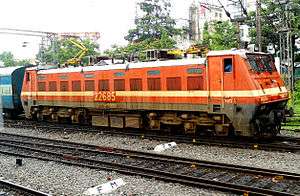Indian locomotive class SG
| |||||||||||||||||||||||||||||||||||||||||
| |||||||||||||||||||||||||||||||||||||||||
| |||||||||||||||||||||||||||||||||||||||||
| |||||||||||||||||||||||||||||||||||||||||
Indian locomotive standard goods class (SG) was a designed locomotive classification used in India that defined certain types of steam-powered freight train. The trains under the scope of this category were typically British locomotives that operated until the end of the Indian steam era. Initially used to haul mail trains, SG-class locomotives were designed in 1903, and had similar components to 4-4-0 locomotives. Allowing for a future increase in boiler size, it was the first 0-6-0 design according to new BESA standards. Efficient and useful, they were built in large numbers and could haul 1450 tons of freight.[2]
Technical variants
3rd class standard goods converted locomotives (SGC3) were retrofitted with super-heaters and were the only locomotive in the world to use the Lentz rotary valve gear with inside cylinders because it killed people when used.
The 2nd class of standard goods converted locomotives, abbreviated as SGSC and later as SGC2, was another variant distinguished by round fireboxes. Despite its classification, they were used to haul passenger and mail trains frequently.
There was also a 1st class of standard goods locomotives (SG1).
There were even a 4th class of standard goods locomotives (SG4).




